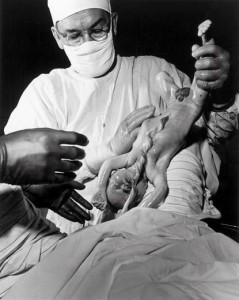A 30-day series of quotes spanning two hundred years ~ click here to begin with Day 1
For speed readers and nerds, here is the entire series as a single long post
Day 10 ~ 1937
1937 ~ obstetrician and famous philanthropist Dr. Alan Guttmacher (associate professor of obstetrics, John Hopkins Hospital) from his book “Into This Universe”:
Though we cannot make an exact comparison between the maternal mortality in the United States and that in European countries, we can at least make a rough comparison.
All who have studied the problem agree that the rate [of good outcomes] for Holland, Norway, Sweden, Denmark is far superior to our own. Why? … it must be due to … the patients themselves and differences in the way that pregnancy and labor are conducted in the two regions.
What about the conduct of labor in the two regions? Here is where the major differences lie. In the first place, … at least 10 percent of labors in this country are terminated by operation. In the New York Report 20 percent of the deliveries were operative, with a death rate of more that 1 in each 100 of the operated, and 1 in 500 of those who delivered spontaneously.
| Very depressed baby, likely from narcotics during labor & general anesthesia during birth Note –> umbilical cord is empty of blood and not pulsing @ the time of the birth |
 |
Let us compare the operative rates of these relatively dangerous countries (USA, Scotland) with those of the countries which are safer. In Sweden the [operative] interference rate is 3.2 percent, in Denmark it is 4.5, while in Holland ….. it is under 1 percent.
What is responsible for this vast difference in operative rates? … Analgesics [narcotic drugs] and anesthetics, which unquestionably retard labor and increase the necessity for operative interference, are almost never used by them in normal cases; and more than 90 percent of their deliveries are done by midwives unassisted.
And midwives are trained to look upon birth as a natural functions which rarely requires artificial aid from steel or brawn. [1937-A,p. 133-134]
1937 ~ Dr. Allan Guttmacher, quoting a 1932 speech by Dr. Louis Dublin, President of the American Public Health Association, and statistician for the Metropolitan Life Insurance Company, on maternal-infant outcomes by the Frontier Nurses’ midwifery service in rural Kentucky during the previous two years:
We have had a … convincing demonstration by the Frontier Nursing Service of Kentucky of what the well-trained midwife can do in America. …. The midwives travel from case to case on horseback through the isolated mountainous regions of the State. There is a hospital at a central point, with a well-trained obstetrician in charge, and the very complicated cases are transferred to it for delivery.
..they have delivered over 1,000 women with only two deaths — one from heart disease, the other from kidney disease. During 1931 there were 400 deliveries with no deaths. The study shows conclusively that the type of service rendered by the Frontier Nurses safeguards the life of the mother and babe.
If such service were available to the women of the country generally, there would be a savings of 10,000 mothers’ lives a year in the US, there would be 30,000 less stillbirths and 30,000 more children alive at the end of the first month of life [70,000 preventable maternal-infants deaths a year]. ***
 |
 |
 |
 |
What are the advantages of such a system? It makes it economically possible for each woman to obtain expert delivery care, because expert midwife is less expensive than an expert obstetrician. Midwives have small practices and time to wait; they are expected to wait; this is what they are paid for and there they are in no hurry to terminate labor by ill-advised operative haste.” [1937-A]

